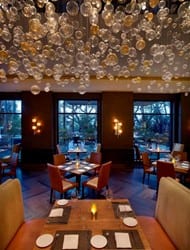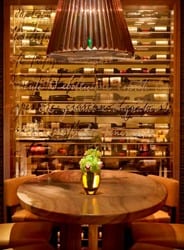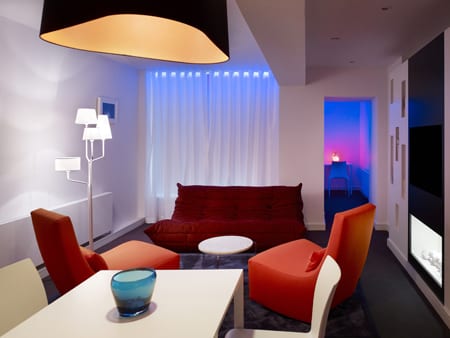 The new dining experience at the Four Seasons Hotel Los Angeles at Beverly Hills, Culina, Modern Italian represents a fusion of sorts-between the hotel and its neighbors (part of the Four Seasons’ push to make their restaurants local culinary destinations themselves) and the indoors and outdoors. “The thing that really works great about Culina is that it reaches out to the LA community,” says Jennifer Johanson, president and CEO of longtime Four Seasons collaborator, San Rafael, California-based EDG Interior Architecture + Design, also noting that the restaurant has direct access to the street so people don’t have to walk through the hotel.
The new dining experience at the Four Seasons Hotel Los Angeles at Beverly Hills, Culina, Modern Italian represents a fusion of sorts-between the hotel and its neighbors (part of the Four Seasons’ push to make their restaurants local culinary destinations themselves) and the indoors and outdoors. “The thing that really works great about Culina is that it reaches out to the LA community,” says Jennifer Johanson, president and CEO of longtime Four Seasons collaborator, San Rafael, California-based EDG Interior Architecture + Design, also noting that the restaurant has direct access to the street so people don’t have to walk through the hotel.

 The blending of spaces was priority to make this modern interpretation of an Italian enoteca inviting to both hotel guests and local diners. Johanson researched enotecas and just like the food, she found that the design had to be lighter and speak to the culture of a casual neighborhood bistro. “What people want is something more casual and approachable,” she says. “It’s still in the Four Seasons, it’s still Beverly Hills, so it has to have a certain panache and elegance.”
The blending of spaces was priority to make this modern interpretation of an Italian enoteca inviting to both hotel guests and local diners. Johanson researched enotecas and just like the food, she found that the design had to be lighter and speak to the culture of a casual neighborhood bistro. “What people want is something more casual and approachable,” she says. “It’s still in the Four Seasons, it’s still Beverly Hills, so it has to have a certain panache and elegance.”
 To create a more airy, open space, walls were knocked down and windows were transformed: Johanson took the windows and broke out the arched top and made them floor-to-ceiling frameless glass windows instead of French doors. “The key thing this restaurant needed to be successful was to be an indoor/outdoor restaurant,” explains Johanson. And from the inside to the outside, it’s a seamless transition-large picture windows that look to the outside give diners a view of the lit landscaping, which is full of intricate details like a modern fountain, trellises, living wall, and outdoor seating of different heights surrounding a fire and water feature. “Especially in the day, you feel like you’re dining in a garden room,” she says.
To create a more airy, open space, walls were knocked down and windows were transformed: Johanson took the windows and broke out the arched top and made them floor-to-ceiling frameless glass windows instead of French doors. “The key thing this restaurant needed to be successful was to be an indoor/outdoor restaurant,” explains Johanson. And from the inside to the outside, it’s a seamless transition-large picture windows that look to the outside give diners a view of the lit landscaping, which is full of intricate details like a modern fountain, trellises, living wall, and outdoor seating of different heights surrounding a fire and water feature. “Especially in the day, you feel like you’re dining in a garden room,” she says.
 Bright and dark greens (for olive oil), chartreuse, and brown are found throughout Culina’s rustic interiors and for furnishings, woods that are hardly found in an restaurant were used including a 200-year-old Magnolia tree that they turned into high tasting tables in front of the wine room. Other Italian elements prevail: recipes for such favorites like tiramisu and red sauce are etched into communal tables and the wine room windows.
Bright and dark greens (for olive oil), chartreuse, and brown are found throughout Culina’s rustic interiors and for furnishings, woods that are hardly found in an restaurant were used including a 200-year-old Magnolia tree that they turned into high tasting tables in front of the wine room. Other Italian elements prevail: recipes for such favorites like tiramisu and red sauce are etched into communal tables and the wine room windows.
“What it was to what it is now is remarkable,” Johanson says. “It really wasn’t that difficult to transform it when we just took out a few walls. It’s just amazing what can happen when you do that.”
For an interview with Guy Rigby on Four Seasons’ new F&B initiatives, click here.


